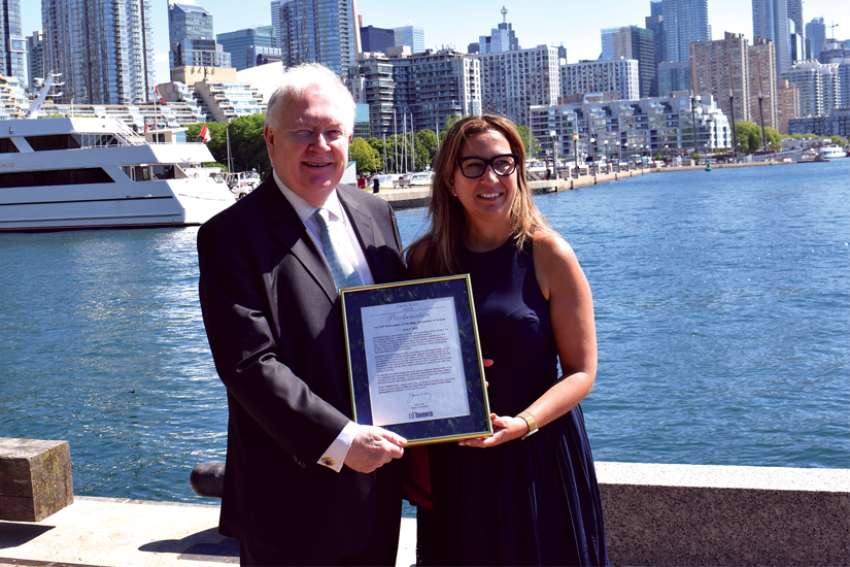This year commemorates the 175th anniversary of the arrival of the first migrant ships travelling from Ireland to Toronto during the peak of the mass exodus of nearly 100,000 famine migrants. In the summer of 1847, some 38,000 migrants arrived in Toronto, more than doubling the city’s population of just 20,000 people. Many would go on to die in the fever sheds set up along the waterfront, including Toronto’s Bishop Michael Power, who ministered to those struck with typhus and other diseases on their journey to the new land.
These, and the thousands more who would follow, would soon make their mark on the fabric of Toronto’s — and Canada’s —identity. Robert G. Kearns, Canada Ireland Foundation (CIF) chair and founder, said these migrants represent the beginnings of the legacy of Toronto as a place of opportunity and refuge for thousands of migrants who continue to arrive annually.
“When we think about these moments, we should maybe think about the migrants who have come since then,” said Kearns. “(Most recently) we’ve had migrants coming from Syria, from Afghanistan and now from Ukraine. I believe for as long as the city of Toronto is thriving and prospering, we will continue to welcome visitors and migrants to the city. Each wave of migrants brings a slight adjustment to the blend of what makes this city so special. ... and we’re all enriched by it.”
At Ireland Park on the shores of Lake Ontario, Toronto’s Deputy Mayor Ana Bailão presented the CIF with a declaration proclaiming June 6, 2022 as the official 175th anniversary of their arrival. The proclamation ceremony is just one of a series of CIF commemorative events and activities planned over the course of the year.
The story of Irish Catholics is particularly relevant with this migration. Between 1815 and 1845 about 495,000 Irish came to Canada and 70 per cent of them were Anglican or Presbyterian. Only 30 per cent were Catholic. But beginning in 1847, the worst year of the famine, those numbers switched around as 70 per cent of the nearly 100,000 who set out were Catholic.
Kearns says the loyalty shown by the Catholic Irish after the Fenian raids solidified their place in Canadian history. The Fenians were a secret society of Irish patriots who had emigrated from Ireland to the United States and from 1866 to 1871 launched several small, armed attacks in Canada. The intention of their movement was to try to take Canadian territory by force in order to exchange it with Britain for Irish independence.
“I think the Irish Catholic community was embraced particularly after the Fenian raids because the Irish community remained loyal to Canada,” said Kearns. “The Fenian raids hoped that they could spur a war between the United States and Canada — it didn’t happen. And not only that but the vast majority of Irish Canadians remained loyal to Canada and didn’t rise up as the Fenians had hoped.”
Many Irish Catholics would continue to show their loyalty, culminating in thousands volunteering to fight in the First World War and that “really reversed and expunged any negative perceptions that had developed with the famine migrants arrival,” said Kearns.
“So that cemented their place in the Canadian social fabric and history. And then they just worked hard and their faith was important to them.”
Ireland Park opened in 2007 on Éireann Quay, adjoining the Canada Malting silos at the foot of Bathurst Street and features five sculptures by artist Rowan Gillespie depicting the arrival of migrants. Seven sculptures by the same artist stand on the shores in Dublin depicting their departure. And in 2021, Grasett Park was opened on Adelaide Street at Widmer Street in downtown Toronto, named in honour of Dr. George Robert Grasett commemorating the sacrifices made by those who aided the sick after they arrived in the city.
The 175th anniversary ceremony also revealed eight panels that tell the history of the famine and the story of Canada and Toronto during the tragedy. The names of those who arrived on the shores of Toronto are engraved in the limestone wall in Ireland Park. So far there are 675 names and as researchers uncover more, those names will be added.
Kearns says these projects are just the beginning. The last piece will be a building in the Bathurst Quay neighbourhood which will become a visitor centre for the Ireland Park and a place to celebrate Irish cultural and historical contributions to Canada. The building is loosely projected to be completed in 2023 or 2024. The CIL is working to raise another $6-7 million on top of the $8 million already raised for the project.


